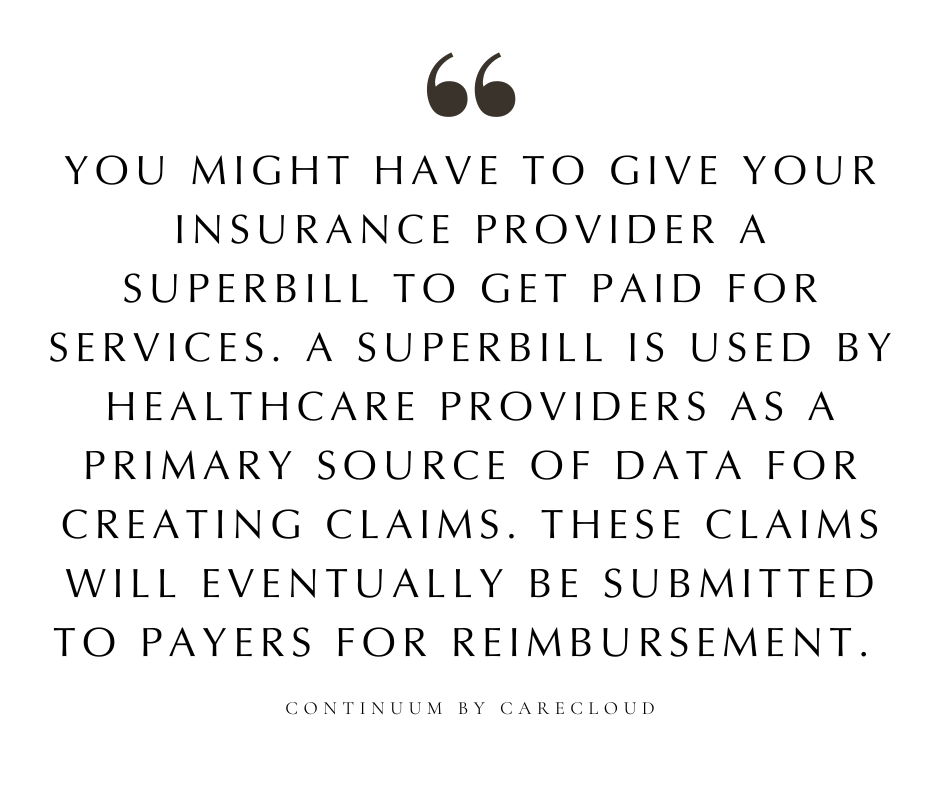
What is a Medical Insurance Superbill? How is it Used?
Summary
This article explains the superbill concept, a detailed form used by healthcare providers for insurance claims. It covers when to request a superbill, such as for out-of-network services or for services not directly billed to insurance. The piece also offers insight into how superbills can facilitate reimbursement through health insurance, HSAs, or FSAs, particularly highlighting their use for women’s health services.
Reflection Questions
- How does the superbill process empower patients in managing their healthcare expenses?
- What challenges might patients face when using superbills for insurance reimbursement, and how can these be mitigated?
- Why is it particularly important for women to understand and utilize superbills for their healthcare services?
Journal Prompt
Reflect on a time when you had to navigate healthcare expenses and insurance claims. Consider how knowledge of superbills might have impacted that experience. Write about how you can use this information to better manage future healthcare expenses or advise others in similar situations.
To all the women navigating the complexities of healthcare: remember that you deserve to be supported and reimbursed for the essential services that contribute to your well-being, including acupuncture, specialized tests ordered by functional medicine doctors, therapy sessions, and beyond. These services play a vital role in maintaining and improving your health, and it’s important to leverage the benefits of your insurance policies, HSAs, or FSAs to their fullest extent by submitting superbills when appropriate.
While the process of submitting superbills and managing insurance claims can seem daunting, it’s a crucial step towards ensuring you are fairly compensated for your healthcare expenses. Don’t hesitate to seek out these beneficial services, armed with the knowledge that you have the tools and the right to pursue reimbursement. What is a superbill? Let’s get into it so you know what to do!
What is a Superbill for Insurance?

A superbill is a detailed form used by healthcare providers that outlines the services provided to a patient. It includes all the information necessary for an insurance company to process a claim. This typically includes the provider’s information, the patient’s information, the dates of service, the codes for the diagnoses and procedures performed (usually in ICD-10 and CPT coding systems, respectively), and the charges for each service.
Suppose a healthcare provider does not directly bill insurance companies or a patient sees an out-of-network provider. In that case, a superbill can be given to the patient to submit to their insurance company for reimbursement. It’s a important document for patients who are managing their medical expenses, especially for those who need to prove their healthcare spending for insurance or tax deduction purposes.
Answering All Your FAQ’s About Superbills
When Would You Ask for a Superbill?

You might ask for a superbill in several scenarios, primarily related to healthcare billing and insurance claims. In all of the following scenarios, the key to effectively using a superbill is understanding your health insurance policy’s coverage, including what types of services are eligible for reimbursement, how out-of-network benefits work, and any requirements for submitting claims for out-of-pocket expenses.
Always communicate with your healthcare provider and insurance company to ensure that you have all the necessary information and documentation for your specific situation. Below are common situations where requesting a superbill would be appropriate.
Out-of-Network Services
When you see a provider who is not part of your insurance network, the insurance company may not directly pay the provider, as out-of-network benefits often differ from in-network benefits. In such cases, you pay the provider directly and then submit a superbill to your insurance for reimbursement. The amount reimbursed depends on your plan’s out-of-network coverage policies.
Services Not Directly Billed to Insurance
Some healthcare providers choose not to engage with insurance companies due to the complexities of billing and reimbursement processes. After paying for these services out of pocket, you can submit a superbill to your insurance to potentially receive reimbursement based on your coverage.
Health Savings Account (HSA) or Flexible Spending Account (FSA) Reimbursement

HSAs and FSAs allow you to pay for eligible healthcare expenses with pre-tax dollars. If you’ve paid out of pocket for a qualified medical expense, a superbill can be submitted to your HSA or FSA administrator to request reimbursement from your account.
Insurance Deductibles and Co-Insurance
Deductibles are the amount you pay for covered healthcare services before your insurance plan starts to pay. Co-insurance is your share of the costs of a covered healthcare service. If you’re tracking expenses towards your deductible or paying co-insurance, a superbill provides the necessary documentation to prove these out-of-pocket expenses to your insurance company.
Medical Tax Deductions
The IRS allows individuals to deduct qualified medical expenses that exceed a certain percentage of their adjusted gross income. A superbill serves as a detailed receipt for these expenses, which can be useful when itemizing deductions on your tax return.
Fuel your creative fire & be a part of a supportive community that values how you love to live.
subscribe to our newsletter
*please check your Spam folder for the latest DesignDash Magazine issue immediately after subscription

Discrepancy or Dispute with Insurance Claims
If there’s a disagreement between what your insurance company decides to cover and what you believe should have been covered, a superbill can offer detailed information about the services provided, the cost, and the healthcare provider’s diagnosis and treatment codes. This information can be critical when appealing a decision made by your insurance company.
Specialized or Alternative Treatments
For healthcare services that fall outside of conventional medical treatments (such as concierge medicine, fertility treatments, or functional medicine), insurance coverage can vary widely. A superbill allows you to submit detailed information about these services to your insurance company for potential reimbursement, depending on your policy’s stipulations regarding such treatments.
Which Women’s Health Services Are Often Covered?

Women can use superbills to seek reimbursement for healthcare services like concierge medicine, fertility treatments, functional medicine consultations, and similar services, provided that these services are covered under their health insurance plan or are eligible for reimbursement through a Health Savings Account (HSA) or Flexible Spending Account (FSA). Let’s take a closer look at these examples of medical and health services.
Therapy Sessions
Women (and anyone seeking therapeutic services) can request a superbill for therapy sessions. This is especially relevant in situations where the therapist does not directly bill insurance companies, or if the patient is seeing a therapist who is out-of-network with their insurance plan.
Many people pay out-of-pocket for therapy sessions with the intention of seeking reimbursement from their insurance company or using their Health Savings Account (HSA) or Flexible Spending Account (FSA) for eligible mental health services.
Concierge Medicine
This model charges patients a retainer for enhanced care services. Some insurance plans may cover the actual medical services provided under this model, even if the retainer fee itself is not covered. A superbill can be used to itemize these services for reimbursement.
Fertility Treatments
While coverage varies greatly by insurance plan, certain fertility services and treatments may be reimbursable. Patients can submit a superbill to their insurance for these services, depending on their plan’s specifics.
Functional Medicine Doctor Sessions
Functional medicine focuses on identifying and addressing the root cause of diseases. Although not all insurance plans cover functional medicine and many functional health care providers do not accept insurance, patients who receive these services can submit a superbill for potential reimbursement for any covered services. For example, insurance benefits typically cover lab tests, imaging, and certain procedures as long as you provide the proper procedure codes or CPT codes.
What Will You Find on a Superbill?

Now that we know what a superbill is, let’s delve into what this document actually includes before you ask for one to send to your insurance payer. A superbill contains detailed information about the healthcare services provided to a patient, which is necessary for insurance claims or reimbursement purposes. Here’s what you can typically find on a superbill for your healthcare claim.
Provider Information: This includes the healthcare provider’s full name, qualifications, address, phone number, and tax identification number (TIN). Sometimes, it also includes the National Provider Identifier (NPI), which is a unique identification number for covered healthcare providers.
Patient Information: The patient’s full name, date of birth, address, and phone number. It may also include the patient’s insurance information, such as the policy number and the insurance company’s contact information.
Visit Information: The date(s) of the service(s) provided, along with the place of service (e.g., office, hospital).
Diagnosis Codes: Diagnostic codes are codes from the International Classification of Diseases (ICD-10) that describe the patient’s diagnosis or condition. These codes justify the need for the services provided.
Procedure or Service Code: These are Current Procedural Terminology (CPT) codes or Healthcare Common Procedure Coding System (HCPCS) codes that describe the specific services, treatments, or procedures provided to the patient.
Service Descriptions: Brief descriptions of the services provided, which correspond to the procedure codes.
Fees: The charge for each service provided. This section lists the cost associated with each CPT or HCPCS code.
Provider’s Signature: The healthcare provider’s or authorized personnel’s signature, certifying the accuracy of the information on the superbill.
Modifiers: These are additional codes that may be used to provide more detail about a procedure code, such as whether a service was bilateral, was an extended service, or involved unusual circumstances.
Total Charges: The total amount charged for all services provided during the visit.
Payment Information: Some superbills may include a section for payments received at the time of service.
Additional Notes: Any other relevant information that might be needed by the insurance company for processing the claim, such as referral information, prior authorization numbers, or explanations for certain services.
Submitting a Superbill to Your Insurance Provider

Submitting a superbill to your insurance company for reimbursement involves several steps. Remember, the process and requirements for submitting a superbill can vary by insurance company, so it’s important to familiarize yourself with your specific insurer’s procedures. Additionally, always keep copies of all documents and correspondence related to your claim for your records. While the exact process may vary slightly depending on your insurance provider, the general procedure is as follows.
Step 1: Obtain the Superbill
After receiving healthcare services, request a superbill from your provider. This document should detail the services you received, including diagnosis and procedure codes, the provider’s information, your information, and the fees charged. Ensure the superbill is complete and accurate, as it is the primary document your insurance will use to assess your claim.
Step 2: Review Your Insurance Policy
Before submitting your superbill, it’s crucial to understand your insurance coverage, particularly for out-of-network services if applicable. Knowing your policy helps identify what the insurance is likely to cover and informs you of your deductible, copayment, or coinsurance responsibilities. It also prepares you for any specific documentation or procedural requirements your insurer may have for submitting claims.
Step 3: Complete Any Required Insurance Forms

Many insurers require specific claim forms to be filled out in addition to the superbill. These forms typically ask for detailed information about the patient, the provider, and the services rendered. Download the necessary forms from your insurance company’s website or request them via customer service. Completing these accurately is essential for the successful processing of your claim.
Step 4: Prepare Your Submission Packet
Gather your completed superbill, any required claim forms, and supporting documentation such as receipts or payment proofs. Ensure you make copies of all items for your records before sending the originals to your insurance company. This packet should contain everything your insurer needs to process your claim.
Step 5: Submit the Packet to Your Insurance Company
Identify the correct submission method and address for sending your claim to your insurance company. Some insurers allow online submissions, while others may require mail. If sending by mail, consider using a method that provides tracking and delivery confirmation to ensure your documents are received. Accurately following your insurer’s submission guidelines is critical to avoid any processing delays.
Step 6: Follow Up
After submitting your claim, it’s important to monitor its status. Many insurance companies offer online portals where you can check the progress of your claim. If you notice any delays or if your claim status is unclear, don’t hesitate to contact your insurance company for an update. Prompt follow-up can help resolve any issues that might be holding up your claim.
Step 7: Appeal If Necessary
If your claim is denied, review the reasons for the denial carefully. If you believe the denial was in error, or if you have additional information that could affect the decision, consider filing an appeal. Your denial letter should include instructions on how to initiate an appeal. This process might involve submitting additional documentation or a detailed letter explaining why the services should be covered. The appeals process can be complex, so it’s important to be thorough and persistent.
Final Thoughts on Submitting a Superbill for Insurance Reimbursement

Your health and well-being are invaluable investments, and taking these steps ensures you are advocating for the care you deserve. Remember, your health is worth every effort, and navigating the reimbursement process is a proactive way to support your journey towards wellness and vitality.
Design Dash
Join us in designing a life you love.
Women, In Their Own Words: Jamie Young
LIKE 4 LEAVE COMMENT 0 5 min read SummaryJamie Young, Founder and Creative Director of Jamie Young Co., shares her journey of balancing artistry and entrepreneurship over nearly 30 years in the design industry. She discusses finding inspiration in unexpected places, evolving her creative process, and the challenges women face in the business world. Jamie…
How to Set Financial Goals for Your Interior Design Business
From prioritizing the Big Financial Four to making each goal SMART, here’s how to set and track actionable financial goals for your interior design firm.
Should You Work with a Business Coach or Financial Advisor?
The decision to work with a business coach, financial advisor, or both will come down to your individual circumstances and priorities. Read on to learn more!
Turning Setbacks into Opportunities: Transform Challenges into Success
LIKE 0 LEAVE COMMENT 0 10 min read Summary Reflection Questions Journal Prompt Setbacks — those unexpected roadblocks that appear just when we think we’ve got everything figured out. Whether it’s a project gone awry at work or a personal goal taking an unexpected turn, we’ve all experienced them. But what if these setbacks could…
Raising Resilient Children: Building Confidence, Strength, and Adaptability
LIKE 0 LEAVE COMMENT 0 11 min read Summary Reflection Questions Journal Prompt Your child comes home from school, slumps onto the couch, and declares they’re never going back because someone made fun of their new haircut. As a parent, your heart breaks a little. But these moments are opportunities to help your child develop…
A Guide to Setting Personal Goals in Midlife
LIKE 0 LEAVE COMMENT 0 8 min read Summary Reflection Questions Journal Prompt Midlife is often portrayed as a stage where we’re supposed to have everything figured out. However, the reality is that most of us are still navigating life’s complexities, and that’s perfectly fine. In fact, this period can be an ideal time for…








